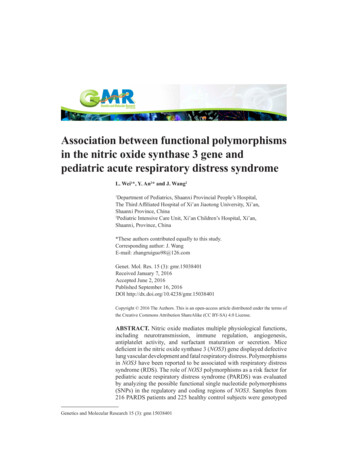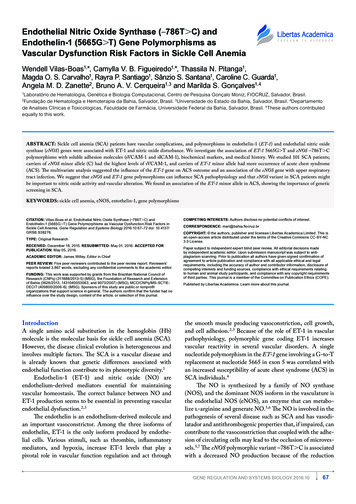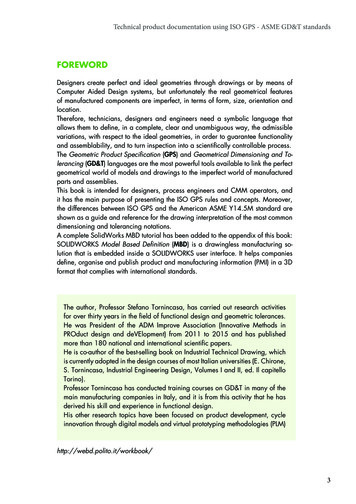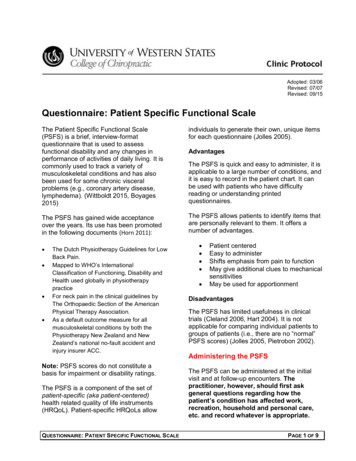
Transcription
Association between functional polymorphismsin the nitric oxide synthase 3 gene andpediatric acute respiratory distress syndromeL. Wei1*, Y. An2* and J. Wang2Department of Pediatrics, Shaanxi Provincial People’s Hospital,The Third Affiliated Hospital of Xi’an Jiaotong University, Xi’an,Shaanxi Province, China2Pediatric Intensive Care Unit, Xi’an Children’s Hospital, Xi’an,Shaanxi, Province, China1*These authors contributed equally to this study.Corresponding author: J. WangE-mail: zhangruiguo98@126.comGenet. Mol. Res. 15 (3): gmr.15038401Received January 7, 2016Accepted June 2, 2016Published September 16, 2016DOI http://dx.doi.org/10.4238/gmr.15038401Copyright 2016 The Authors. This is an open-access article distributed under the terms ofthe Creative Commons Attribution ShareAlike (CC BY-SA) 4.0 License.ABSTRACT. Nitric oxide mediates multiple physiological functions,including neurotransmission, immune regulation, angiogenesis,antiplatelet activity, and surfactant maturation or secretion. Micedeficient in the nitric oxide synthase 3 (NOS3) gene displayed defectivelung vascular development and fatal respiratory distress. Polymorphismsin NOS3 have been reported to be associated with respiratory distresssyndrome (RDS). The role of NOS3 polymorphisms as a risk factor forpediatric acute respiratory distress syndrome (PARDS) was evaluatedby analyzing the possible functional single nucleotide polymorphisms(SNPs) in the regulatory and coding regions of NOS3. Samples from216 PARDS patients and 225 healthy control subjects were genotypedGenetics and Molecular Research 15 (3): gmr.15038401
L. Wei et al.2at 4 SNP loci (rs11771443 and rs3918188 in the promoter region,rs1799983 in exon 7, and rs7830 at the intron24-exon23 boundary).Statistically significant differences were observed in the allelic orgenotypic frequencies of the rs1799983 and rs11771443 polymorphismsin NOS3. The T and G alleles of rs1799983 and rs11771443 wereassociated with a significantly higher risk of PARDS compared to theC allele (P 0.030) and the T allele (P 0.004), respectively. Stronglinkage disequilibrium was observed in one block (D' 0.9). Subjectswith PARDS displayed significantly fewer T-C haplotypes (P 0.013)in block 1 (rs1799983-rs11771443). These findings indicate that NOS3polymorphisms play a definitive role in PARDS, and therefore may beuseful for future genetic or neurobiological studies on RDS.Key words: Pediatric acute respiratory distress syndrome;Nitric oxide synthase 3; Single nucleotide polymorphismsINTRODUCTIONAcute respiratory distress syndrome (ARDS) is an important cause of acute respiratoryfailure, which is often associated with multiple organ failure (Rubenfeld et al., 2005). The riskfactors for ARDS include infection, alcohol abuse, cigarette smoke exposure, and race (Mosset al., 1996). Genetic susceptibility may also be an important determinant of ARDS incidence(Matthay et al., 2012).Nitric oxide (NO) is a modulator of apoptotic and inflammatory cascades andendothelial permeability. NO synthesis is catalyzed by the nitric oxide synthase (NOS) enzymefamily, which includes several neuronal (NOS1), inducible (NOS2), and endothelial (eNOS,NOS3) synthases (Nikkari et al., 2015). The most important member of the NOS family thatis involved in the basal release of vascular NO is eNOS. Endogenous NO plays a critical rolein decreasing pulmonary vascular resistance and improving ventilation-perfusion matchingafter birth, enabling the reversal of pulmonary hypertension (Han et al., 2004). eNOS-deficientmice display major defects in lung morphogenesis (Sung et al., 2015) that cause respiratorydistress and death within the first hours of life in a majority of animals (Han et al., 2004). Therole of eNOS in lung development, which may influence the clinical syndromes of neonatalrespiratory distress, remains to be elucidated (Han et al., 2004). Wu et al. (2014) suggestedthat eNOS uncoupling contributes to superoxide production and barrier dysfunction in thelung microvasculature after exposure to lipopolysaccharides. The results of this study alsoimplicated the Nox2-mediated eNOS-S-glutathionylation in LPS-induced eNOS uncouplingin the lung microvasculature (Wu et al., 2014). A study of the SNP rs1799983 in NOS3 showeda significant increase in the GG genotype and G allele frequencies in groups with respiratorydistress syndrome (Shen et al., 2014). Additional studies must be conducted to determine iffunctional SNPs in NOS3 modulate the risk of disease by themselves or by correlating withother causative SNPs, and their effect on other populations.Based on the growing relevance of NOS3 in RDS, we hypothesized that thefunctional variants of NOS3 might contribute significantly to the predisposition to pediatricacute respiratory distress syndrome (PARDS). In this study, functional SNPs in the promoterregion, 5'- and 3'-untranslated regions, exons, and the intron-exon boundary of NOS3 wereGenetics and Molecular Research 15 (3): gmr.15038401
3Role of NOS3 polymorphisms in PARDSsystematically screened. We investigated the association between four SNPs in NOS3(rs11771443 and rs3918188 in the promoter region, rs1799983 in exon 7, and rs7830 in theintron24-exon23 boundary) and the risk of PARDS in a Chinese population, and the potentialpathogenesis of PARDS patients expressing potentially functional SNPs.MATERIAL AND METHODSSubjectsTwo hundred and sixteen unrelated subjects with PARDS were recruited fromthe Shaanxi Provincial People’s Hospital and Xi’an Children’s Hospital between March2010 and April 2015. RDS was characterized by a need for supplemental oxygen, a chestradiograph consistent with RDS, and the need for continuous positive airway pressureor mechanical ventilation within the first 24 h of life. The control group was composedof 225 unrelated healthy individuals recruited from the Medical Examination Center ofShaanxi Provincial People’s Hospital. Subjects who suffered from asthma or showedsymptoms of allergy were excluded. The exclusion criteria included the presence ofcongenital anomalies, severe infection, and inherited metabolic disorders. Clinical dataof all individuals, including the gestational age, gender, birth weight, and maternal andneonatal clinical histories, were obtained from the patient medical records. All participantsbelonged to the Han Chinese ethnicity and were genetically unrelated individuals fromthe Henan Province of China. The study complied with the guidelines of the local medicalEthics Committee, and written informed consent was obtained from all participantsrecruited to this study.GenotypingPeripheral blood (3-5 mL) was obtained from all patients in tubes coated withEDTA. Genomic DNA was extracted from blood leukocytes using an EZNATM Blood DNAMidi kit (Omega Bio-Tek, Norcross, GA, USA) according to the manufacturer protocols.Primers for PCR and single-base extension were designed using the Assay Designersoftware package (Sequenom Inc., San Diego, CA, USA) (Table 1). SNP genotyping wasperformed using the SNaPshot SNP technology according to the manufacturer protocols.Primary data were analyzed by GeneMapper 4.1 (Applied Biosystems, Foster City, CA,USA). The genotypes were determined based on the nucleotide present at the SNP site,as visualized by one or two differently colored peaks in the chromatograms. For qualitycontrol, 5% of the recruited subjects were randomly genotyped twice by researchers in ablind manner, with a reproducibility of 100%.Table 1. Primer sequences used to genotype the single nucleotide polymorphisms (SNPs) in the extracellularnitric oxide synthase (eNOS) gene.SNPsForward primersReverse primersExtension CGenetics and Molecular Research 15 (3): gmr.15038401
L. Wei et al.4Statistical analysisThe genotype and allele frequencies for each individual polymorphism, as well asthe Hardy-Weinberg equilibrium of controls, were calculated using the chi-square test. Theassociation between polymorphisms and heroin addiction was assessed by the Pearson chisquare test. The odds ratio (OR) and 95% confidence interval (CI) was calculated by binarylogistic regression. The P values were calculated based on codominant, dominant (for therare allele), heterosis, and recessive (for the rare allele) models of inheritance. The pairwiselinkage disequilibrium (LD) statistics (D' and r2) and haplotype frequencies were comparedusing Haploview 4.0, in order to construct haplotype blocks defined by D' 0.9 and r2 0.8.All statistical analyses were carried out using SPSS 20.0 (SPSS Inc., Chicago, IL, USA).RESULTSThe controls showed no significant deviation from the HWE for any of the SNPs.LD analyses of the patient and control data revealed that the rs1799983 and rs11771443polymorphisms are located in haplotype block 1. The haplotype structure and pairwise LDvalues (r2) are shown in Figure 1. The structure of the haplotype blocks and pairwise LDscalculated for each patient group were roughly similar to those of the controls. The genotypedistributions, allelic frequencies, and haplotypes of control and patient groups, together withthe results of statistical analysis, are summarized in Tables 2 and 3.Figure 1. Linkage disequilibrium plot of single nucleotide polymorphisms in NOS3 and in controls.The rs1799983 genotype distribution was weakly linked to PARDS. The frequencyof the G allele was significantly higher in PARDS patients than in the healthy controls (P 0.030; OR 6.143, 95%CI 4.669-8.082). Additionally, we observed a strong correlationbetween the rs11771443 allele frequencies and PARDS. PARDS subjects also exhibiteda significantly higher frequency of the T allele (P 0.004; OR 3.057, 95%CI 2.3983.897) compared to the controls. The differences retained statistical significance afterBonferroni correction (P 0.0125).Furthermore, strong linkage disequilibrium (LD) was observed in rs1799983rs11771443 (D' 0.9). The control subjects showed a significantly higher number of T-Chaplotypes (P 0.013; OR 0.619, 95%CI 0.424-0.903) in block 1. These differencesretained statistical significance after Bonferroni correction.Genetics and Molecular Research 15 (3): gmr.15038401
5Role of NOS3 polymorphisms in PARDSTable 2. Genotypic and allelic frequencies of NOS3 polymorphisms in the controls and patients.VariableMAFNrs1799983GGGTTTG alleleT allelers11771443TTGTGGT alleleG allelers3918188GGGAAAG alleleA allelers7830GGGAAAG alleleA allele0.1400.3910.4440.307Cases (N 216)%Controls (N 8.969.330.7HWEP valueOR (95%CI)0.1520.0010.0030.0004830.1260.0300.541 (0.360-0.815)2.113 (1.388-3.216)0.291 (0.060-1.417)6.143 (4.669-8.082)0.1180.0240.0480.8320.0130.0040.672 (0.453-0.997)0.960 (0.658-1.401)1.779 (1.131-2.799)3.057 (2.398-3.897)0.1340.2620.6780.1450.1800.6280.919 (0.617-1.370)1.321 (0.909-1.922)0.723 (0.451-1.161)3.335 (2.621-4.244)0.7160.5480.2950.4990.5340.2860.818 (0.562-1.191)1.138 (0.782-1.657)1.222 (0.650-2.295)3.939 (3.085-5.029)MAF, minor allele frequency; HWE, Hardy-Weinberg equilibrium; OR, odds ratio; CI, confidence interval.Table 3. Haplotype in block 1 frequencies and the results of their association with risk of pediatric acuterespiratory distress syndrome.HaplotypeT-CG-CG-TCases [N (%)]106 (40.074)67 (31.019)38 (17.593)Controls [N (%)]137 (60.889)56 (24.889)32 (14.222) .3571.28895%CI0.424-0.9030.894-2.0620.771-2.149OR, odds ratio; CI, confidence interval.DISCUSSIONSeveral polymorphisms in NOS3 were identified in this study, among which, threecommon functional polymorphisms, the promoter -786T C (rs2070744) SNP (Aggarwal et al.,2010), the 4b/4a (rs61722009) variable number of tandem repeats (27-bp repeat) in intron 4(Singh et al., 2010; Rahimi et al., 2013), and the functional Glu298Asp (rs1799983) exon 7variant (a G-to-T substitution at position 894 resulting in the replacement of glutamic acid withaspartic acid at codon 298) (Yu et al., 2006; Turan et al., 2010), were investigated. Recent clinicaltrials have proven the beneficiary effects of inhaled NO on respiratory syndromes (Schreiber etal., 2003; Ballard et al., 2006). Our results provide direct evidence that a genetic change in NOS3is linked to PARDS, with the relevant markers being mapped to different locations in NOS3.Moreover, we identified the signals and haplotypes associated with these changes in this region.Godfrey et al. (2007) studied the functional effects of the rs1799983 polymorphismin young healthy volunteers and showed an association between this locus and bluntedGenetics and Molecular Research 15 (3): gmr.15038401
L. Wei et al.6endothelial-dependent vasodilation, possibly resulting from decreased NO synthesis. In thiscase-control association study, the T allele of NOS3 rs1799983 was weakly associated with anincreased risk of PARDS. The rs1799983 polymorphism was suggested to be associated withaltered NOS3 enzyme activity, reduced NO production, and blunted endothelial-dependentvasodilation (Wang et al., 2000). Recent studies have reported significant gestational age-relateddifferences between RDS and the control groups in terms of the Glu298Asp polymorphism.Therefore, the development of RDS was associated with alterations in the eNOS Glu298Aspgenotype frequencies in the Turkish population (Demirçubuk et al., 2013). Although the precisemolecular mechanism underlying our observations is unclear, one possible explanation is thatthe variants of NOS3 may lead to altered gene expression in PARDS patients. We also observeda significantly higher frequency of the G allele of the NOS3 rs11771443 polymorphism inPARDS subjects. The differences retained statistical significance after Bonferroni correction.To our knowledge, this is first report associating the rs11771443 polymorphism in the promoterwith PARDS. The rs2070744 SNP in the promoter region of eNOS has been observed inpatients with vascular disease (Guang-da et al., 2005), recurrent miscarriage (Luo et al., 2013),and glaucoma (Liao et al., 2011). Therefore, our observations strongly suggest that this SNPcould be a useful marker in the long-term monitoring of PARDS.An analysis of the genetic interactions among polymorphisms revealed a strong LD.Haplotype analysis revealed that significantly more T-C haplotypes (in block 1) were observedin controls. These results indicate that patients with the T-C haplotype of NOS3 were lessprone to PARDS. To some extent, this finding further supports the potential role of NOS3polymorphisms in PARDS.The results of this study are subject to certain limitations. For example, as NOS3expression was not analyzed in vivo, the results of this study must be interpreted cautiously.Moreover, further independent research is required to validate our results.In summary, our study demonstrated that SNPs in NOS3, which may alter itsexpression, may partially influence PARDS susceptibility (by playing a role in the developmentand progression of PARDS) in a Chinese Han population.Conflicts of interestThe authors declare no conflict of interest.REFERENCESAggarwal PK, Jain V and Jha V (2010). Endothelial nitric oxide synthase, angiotensin-converting enzyme andangiotensinogen gene polymorphisms in hypertensive disorders of pregnancy. Hypertens. Res. 33: 473-477. http://dx.doi.org/10.1038/hr.2010.23Ballard RA, Truog WE, Cnaan A, Martin RJ, et al.; NO CLD Study Group (2006). Inhaled nitric oxide in preterm infantsundergoing mechanical ventilation. N. Engl. J. Med. 355: 343-353. http://dx.doi.org/10.1056/NEJMoa061088Demirçubuk AG, Coşkun MY, Demiryürek Ş, Dokuyucu R, et al. (2013). Endothelial NOS gene Glu298Asp polymorphismin preterm neonates with respiratory distress syndrome. Pediatr. Pulmonol. 48: 976-980. http://dx.doi.org/10.1002/ppul.22759Godfrey V, Chan SL, Cassidy A, Butler R, et al. (2007). The functional consequence of the Glu298Asp polymorphism ofthe endothelial nitric oxide synthase gene in young healthy volunteers. Cardiovasc. Drug Rev. 25: 280-288. Guang-da X, Qiong-shu W and Wen J (2005). A T-786C polymorphism in 5′-flanking region of the endothelial nitric oxidesynthase gene and endothelium-dependent arterial dilation in Type 2 diabetes. Diabet. Med. 22: 1663-1669. Genetics and Molecular Research 15 (3): gmr.15038401
Role of NOS3 polymorphisms in PARDS7Han RN, Babaei S, Robb M, Lee T, et al. (2004). Defective lung vascular development and fatal respiratory distress inendothelial NO synthase-deficient mice: a model of alveolar capillary dysplasia? Circ. Res. 94: 1115-1123. 1ELiao Q, Wang DH and Sun HJ (2011). Association of genetic polymorphisms of eNOS with glaucoma. Mol. Vis. 17: 153-158.Luo L, Li DH, Wei SG, Zhang HB, et al. (2013). Polymorphisms in the endothelial nitric oxide synthase gene associatedwith recurrent miscarriage. Genet. Mol. Res. 12: 3879-3886. ay MA, Ware LB and Zimmerman GA (2012). The acute respiratory distress syndrome. J. Clin. Invest. 122: 27312740. http://dx.doi.org/10.1172/JCI60331Moss M, Bucher B, Moore FA, Moore EE, et al. (1996). The role of chronic alcohol abuse in the development of acuterespiratory distress syndrome in adults. JAMA 275: 50-54. Nikkari ST, Määttä KM and Kunnas TA (2015). Functional inducible nitric oxide synthase gene variants associate withhypertension: a case-control study in a Finnish population - the TAMRISK study. Medicine 94: e1958. i Z, Aghaei A, Rahimi Z and Vaisi-Raygani A (2013). Endothelial nitric oxide synthase (eNOS) 4a/b and G894Tpolymorphisms and susceptibility to preeclampsia. J. Reprod. Infertil. 14: 184-189.Rubenfeld GD, Caldwell E, Peabody E, Weaver J, et al. (2005). Incidence and outcomes of acute lung injury. N. Engl. J.Med. 353: 1685-1693. http://dx.doi.org/10.1056/NEJMoa050333Schreiber MD, Gin-Mestan K, Marks JD, Huo D, et al. (2003). Inhaled nitric oxide in premature infants with the respiratorydistress syndrome. N. Engl. J. Med. 349: 2099-2107. http://dx.doi.org/10.1056/NEJMoa031154Shen W, Du J, Wang B and Zeng Q (2014). Analysis of nitric oxide synthase gene polymorphisms in neonatal respiratory distresssyndrome among the Chinese Han population. Ital. J. Pediatr. 40: 27. http://dx.doi.org/10.1186/1824-7288-40-27Singh A, Sharma D, Raghunandan C and Bhattacharjee J (2010). Role of inflammatory cytokines and eNOS genepolymorphism in pathophysiology of pre-eclampsia. Am. J. Reprod. Immunol. 63: 244-251. Sung JH, Lee BE, Kim JO, Jeon YJ, et al. (2015). Association between eNOS polymorphisms and risk of coronary arterydisease in a Korean population: a meta-analysis. Genet. Mol. Res. 14: 16508-16520. http://dx.doi.org/10.4238/2015.December.9.23Turan F, Ilhan N, Kaman D, Ateş K, et al. (2010). Glu298Asp polymorphism of the endothelial nitric oxide synthase geneand plasma concentrations of asymmetric dimethylarginine in Turkish pre-eclamptic women without fetal growthretardation. J. Obstet. Gynaecol. Res. 36: 495-501. Wang XL, Sim AS, Wang MX, Murrell GA, et al. (2000). Genotype dependent and cigarette specific effects on endothelialnitric oxide synthase gene expression and enzyme activity. FEBS Lett. 471: 45-50. http://dx.doi.org/10.1016/S00145793(00)01356-9Wu F, Szczepaniak WS, Shiva S, Liu H, et al. (2014). Nox2-dependent glutathionylation of endothelial NOS leads touncoupled superoxide production and endothelial barrier dysfunction in acute lung injury. Am. J. Physiol. Lung Cell.Mol. Physiol. 307: L987-L997. http://dx.doi.org/10.1152/ajplung.00063.2014Yu CK, Casas JP, Savvidou MD, Sahemey MK, et al. (2006). Endothelial nitric oxide synthase gene polymorphism(Glu298Asp) and development of pre-eclampsia: a case-control study and a meta-analysis. BMC PregnancyChildbirth 6: 7. http://dx.doi.org/10.1186/1471-2393-6-7Genetics and Molecular Research 15 (3): gmr.15038401
role of eNOS in lung development, which may influence the clinical syndromes of neonatal respiratory distress, remains to be elucidated (Han et al., 2004). Wu et al. (2014) suggested that eNOS uncoupling contributes to superoxide production and barrier dysfunction in the lung microvasculature after exposure to lipopolysaccharides.










